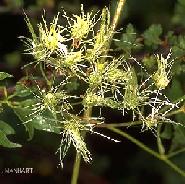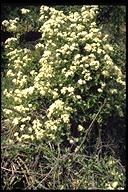
Western Virgin's Bower
Clematis ligusticifolia Nutt.

Western Virgin's Bower
Clematis ligusticifolia Nutt.
A semi-woody vine often attaining a height of 30 feet with a maximum stem diameter of about 3 inches. The young twigs are angled, brittle, smooth, and dull in color, the bark on older stems are gray and stringy. The leaves are compound and have the primary segements again divided, blades of leaflets are 1 1/2 to 2 1/2 inches long and 3/4 to 1 1/2 inches wide. It has small flowers which are about 1/4 inch across, but occur in much profusion that they impart a white color to the whole mass of grow. Later in the season the seeds develop long, feathery, tan-colored tails, which again give the plant a tan or whitish color.
It flowers in the summer (Jun-Sep) and is located on forest edges, woods, riparian deciduous woodlands, moist wooded draws, scrub, secondary sites derived from these, or clearings and pastures, usually near streams or on moist slopes; up to 2600 mountain elevations. ;Virgin's-bower is found throughout the western United States and Canada.
Caution: Virgin's-Bower is a poisonous plant. It can cause severe skin reactions in some people and swollen, inflamed eyelids. If eaten, can cause stomach upset, internal bleeding, and even death.
Uses
Medicine: Infusions prepared from the plants of Clematis ligusticifolia were
used medicinally by Native Americans as a wash for skin eruptions, a lotion for
backaches or swollen limbs, and a lotion to protect one against witches; stems
and leaves were chewed to treat colds and sore throats; decoctions of leaves
were also used as a wash and for stomachaches and cramps; and lathers of leaves
were used to treat boils on humans and on animals.
A decoction of the plant is used to treat colds and sore throats. It has also
been used as a general tonic when feeling out of sorts. An infusion of the white
bark has been used as a febrifuge, an infusion of the roots has been used to
treat headaches and stomach aches, while An infusion of the plant has been used
as a wash for skin eruptions, sores, wounds, backaches, swollen limbs, tired
feet, syphilitic sores, eczema etc.
A poultice of the foliage has been used to treat chest pains and rheumatic
joints, A poultice made from the cut stems has been applied to the teeth for
treating toothache, and also a poultice of the mashed, moistened seeds has been
applied to severe burns. The stalks and roots have been used to make a woman's
contraceptive.
Planting: Prefers a deep moist soil with its roots in the shade. Dislikes
poorly-drained heavy clay soils, but grows well in clay if grit is added for
drainage. Dislikes light sandy soils, but does well on chalk. Succeeds in acid
as well as alkaline soils. hen planting out, in order to avoid the disease
'clematis wilt', it is best to plant the root ball about 1 inch deeper in the
soil. This will also serve to build up a good root crown of growth buds. A
twining plant. The leafstalks wrap themselves around twigs and branches for
support. When a side of the stalk touches an object, the growth on that side
slows down whilst the other side grows at its normal Insert current
seasons growth in early summer.
